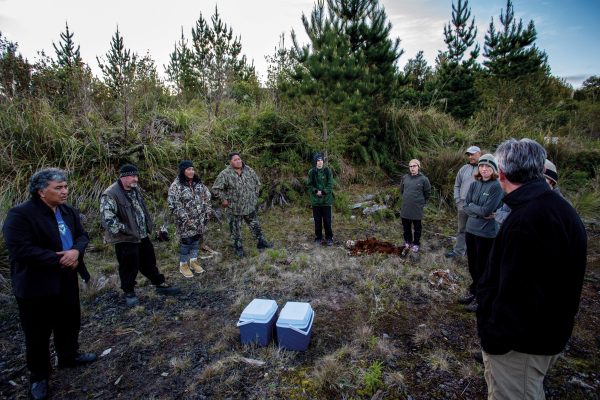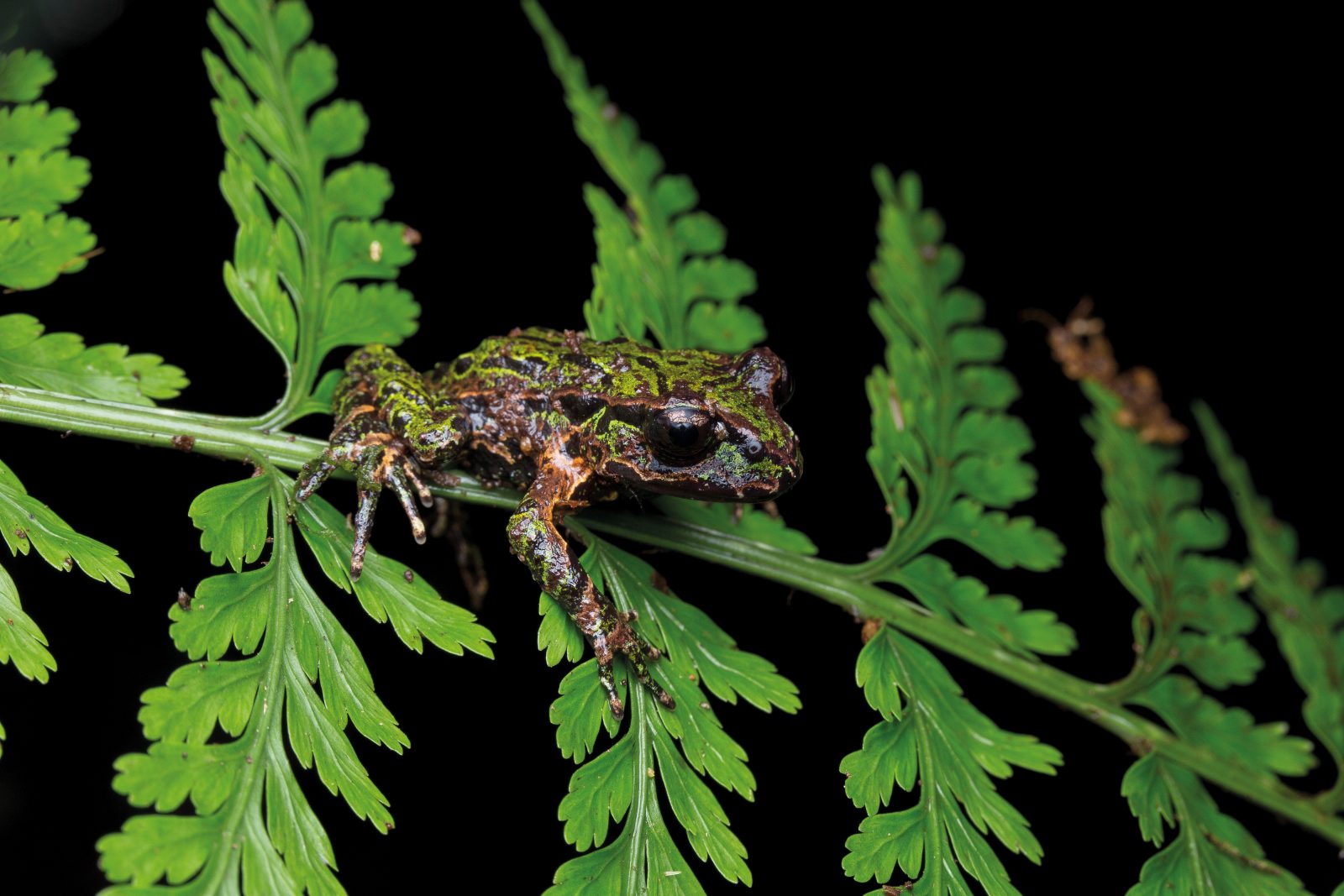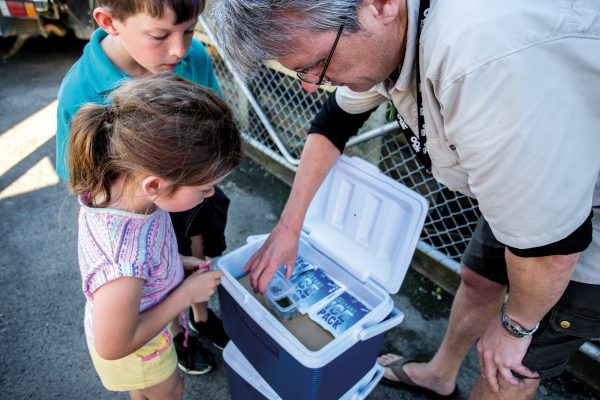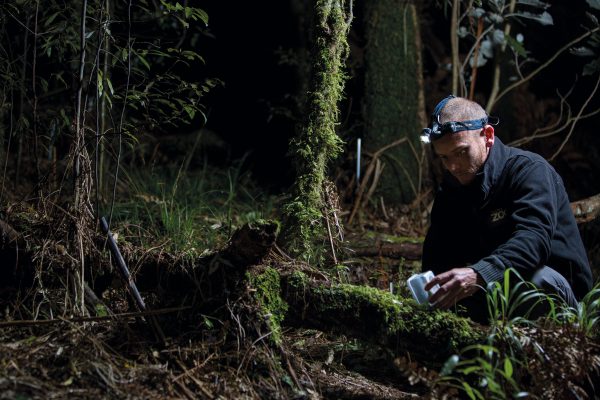
A leap in the dark
Of all the world’s amphibians, the most evolutionarily unusual and critically endangered is the Archey’s frog. The smallest of New Zealand’s four native frogs, this ‘living fossil’ hasn’t changed much in 150 million years. It didn’t evolve ears or a voice, prefers the forest floor to water, and can’t leap without landing in a bellyflop. Why are Archey’s frogs so strange, and what makes them so important?

This is how to spot an Archey’s frog:
First, find a forest wreathed in mist, with high ranges, cool and damp. Archey’s frogs favour two: Whareorino and the Coromandel.
Next, wait for darkness. Slow down. Don’t listen. If you hear a frog croak, it’s Australian—New Zealand frogs are mostly silent. Look underneath rocks and fallen leaves, peer inside decaying logs, part fronds of kiekie. You’ll need an image in your mind, so picture this: glossy skin, green or brown, with long striations of black, somewhere between the size of a matchbox and a fig.
I’m not saying it’s easy. There could be three frogs right in front of you and it would still be the hardest I Spy game of your life. But if you wait, and if you’re lucky, a piece of leaf litter might detach itself from the forest floor and take a step forward, as though it has come to life. Then you’ll see the knobbles on its back, and its long fingers, and if you get close enough, the tiny pulse in its throat.
[Chapter Break]
Delicate frog skeletons appear often enough in the sub-fossil record to suggest they were once widespread around the North Island. Today, Archey’s frog is present in only a couple of high-altitude forests—a few patches in the Coromandel, and a six-kilometre section of Whareorino in the King Country. There may be more Archey’s frog populations hidden away, yet to be discovered, because they keep to a small area and they are ‘cryptic’, which is how ecologists say ‘hard to find’.
New Zealand had seven native frogs before humans arrived, but only four of those species remain. They’re named after three people and a place—Archey’s, Hochstetter’s, Hamilton’s, and Maud Island—and they’re all a bit weird. They have round, not slit pupils. They’re mostly land-dwelling, not water-dwelling. No external eardrums, no vocal sacs, no tadpole stage. Instead, they hatch as froglets, tadpoles with legs, the size of a pumpkin seed. When they do swim, it’s not with a frog kick, but one leg thrusting and then the other, swivelling their heads from side to side as though in serious difficulty. They have muscles to wag a tail, but no tail, and while they can’t jump very well—or rather, they can’t land, bellyflopping after every leap—they often climb several metres up trees.

New Zealand frogs are strange because they diverged from modern frogs in the Triassic period. The Archey’s frogs of today are very similar to frog fossils from 150 million years ago. They offer a glimpse into life on earth long before the Atlantic Ocean was formed, before birds appeared in the fossil record, and before New Zealand broke away from Gondwanaland.
This is why they’re on the Edge List, a document compiled by the Zoological Society of London which ranks species on how ‘evolutionarily distinct and globally endangered’ they are. Because Archey’s frogs are in quite a lot of trouble, they’re in the top spot.
[Chapter Break]
It’s a brisk October night, more winter than spring, but Pureora Forest is always a little colder than the plains of the King Country below. Richard Gibson, Auckland Zoo’s curator of ectotherms and birds, is carrying a blue chilly bin in each hand, stacked with frogs to release in the forest. A small population of Archey’s frogs lives here, a group of 70 brought as part of an emergency translocation in 2006. Amphibian chytrid fungus had just been found in Whareorino, and it had proved deadly to other frog populations.
About two-thirds of the Pureora frogs have been sighted since—which isn’t to say the other third died, just that they’re cryptic. This group of 60 new frogs will add genetic diversity to the community, a decade after the original translocation.
It isn’t a matter of sprinkling frogs across the forest floor. University of Otago PhD student Javiera Cisternas has allocated each of the 60 new frogs a square of forest in an area that has been fenced off from deer and pigs. She has marked long alleyways with thread and pushed marker pegs into the leaf litter where each frog should go.
Later, the frogs will be monitored, and odds are they’ll be close by—the home range of the Maud Island frog, which behaves similarly, moves an average of 1.3 metres every decade.

When Gibson unpacks the chilly bins, people cluster around to get a glimpse of the frogs in their plastic apartments. The iwi of Pureora, Rereahu, are taking part in the release, and later will return to monitor the frogs. Cisternas, who is from Chile, is researching how iwi can be better involved in caring for the species under their kaitiakitanga, or protection.
“A lot of time the iwi have never actually met the animals,” says Cisternas. “They are asked, ‘Could we study them, could we translocate them?’ But have they actually been invited to see a frog? No. The point of my research is to try to facilitate the kaitiakitanga.”
Meanwhile, Rereahu had already created a kaitiaki group in order to learn more about the many species that share their home.
“We like to get involved in the projects that DOC have, to get a bit more knowledge about what they do, and to see what we can do to support,” says Francis Hughes, a member of the kaitiaki group.
So far, she says, she has learned a lot—about Archey’s frogs, short-tailed bats, North Island robins.
“It’s like going to university, only it doesn’t take you years,” she says. “I think, ‘How come we didn’t know all this before?’ But having the opportunity to take part was never there before. You can’t beat real-life experience.”
Rereahu have no mātauranga, or traditional knowledge, of Archey’s frogs—there’s no evidence of the frogs having lived in Pureora in the past—but the iwi have embraced the tiny amphibian to come under their care.
“I have learned that mātauranga is something that is alive,” says Cisternas. “So it doesn’t matter that they didn’t have a special link to the frogs before, they are developing that link now.”
We don’t touch the frogs, in case we’re carrying bacteria on our hands. They slip out of the plastic boxes onto the forest floor, where they dissolve before our eyes, patterned skin melting into the bracken and the texture of the leaf litter.

Later, Rereahu will return to this patch of forest to search for them, becoming part of the frog’s conservation in the process, much-needed champions of the species. This is exactly what Cisternas’s research is about—mobilising people to like frogs.
“You have an environmental problem—to stop frogs
going extinct,” she says. “But to solve that problem you need to address a lot of things that are affecting the frogs, and not all of them are related to biology. A lot of them are related to people.
“So, for me, if you want to work in conservation, you can’t avoid the fact that we’re in a world where humans are impacting things you want to preserve. For me, it’s more natural to involve people than to answer a very specific biological question.”
[Chapter Break]
A few of the biological questions that haven’t yet been answered: What is threatening Archey’s frogs? What role do they play in the ecosystem? Where do they prefer to live?
“My gut feeling is that the best-quality habitat for these frogs is in the top part of the mountains close to the ocean, which have this permanent mist even on the driest days of summer,” says Cisternas. “That’s what happens in the Coromandel and that’s what happens in Whareorino. From that point of view Pureora is a little drier.”
Could Pureora turn out to be a terrible home for frogs?
“We didn’t know when we moved the frogs the first time, and we still don’t know—they are still alive, but they live for 30 years, so we still need to clear up whether they are establishing or dying slowly.”
Cisternas laughs, not morbidly but with resignation, that trying to help a species still involves so much experimentation, and that the success or failure of a translocation takes decades to measure.
But so far, things are looking optimistic for the Pureora frogs, says DOC’s frog recovery group leader Amanda Haigh, and the new release will help them learn more about frog habitat.
“Young frogs have been recorded every year since April 2008, indicating that some of the frogs started breeding the first season after their release,” she says.
The population estimate for Archey’s frogs is vague: somewhere between 5000 and 20,000. They’re classed as ‘critically endangered’ on the International Union for Conservation of Nature’s Red List, largely because of how quickly they can disappear.
[sidebar-1]
Between 1996 and 2001, Victoria University frog researcher Ben Bell recorded decreases of up to 88 per cent in frogs at his Coromandel monitoring sites, which he has been visiting since 1982. This is one of the longest-monitored frog populations in the world, but it’s a sliver of what it once was.
“I used to catch on average about 70, now the average is 14, so we’re getting about a fifth or sixth of what we used to,” says Bell. “The situation is basically that they’re holding their own, but they are not increasing rapidly—it would take a long time, anyway, as they are a slow-breeding species.”
Chytrid fungus, an infectious disease deadly to amphibians around the world, is the likely culprit. It remains a threat to Archey’s frogs, especially with the potential for new strains to mutate and hitchhike to New Zealand.
“The one thing that Archey’s frogs don’t have is a safe haven,” says Richard Gibson. “There’s nowhere they are living in a predator-free environment. There’s one management area, which is Whareorino, and anywhere else Archey’s frogs exist, they exist by chance; they’re managing to eke out a living.”
New Zealand frog experts want to see Archey’s frogs in a predator-free spot somewhere—an offshore island, for instance, or a fenced reserve.

While rat-trapping in Whareorino is making a difference—Archey’s are so abundant that the frogs required for the October translocation were collected in an hour—predator control must be continuous, or the population will likely decline.
University of Otago amphibian expert Phil Bishop would like to see frogs become the headlining act of a sanctuary, a place people could visit specifically to search for frogs.
“It’s very difficult for people in New Zealand to care about an animal they’ll never see in the wild,” he says. “There are some countries that have frog reserves, so they have an area of outstanding natural beauty that has a very healthy frog population, and set that aside as a stronghold for frogs.
“I’d like DOC to manage something from a frog-centric point of view—whereas at the moment, it’s always an add-on, ‘Oh, there’s native frogs there as well, that’s good’.”
Bishop is also interested in investigating the role frogs play in New Zealand ecosystems. Frogs are food for kiwi, he says, so a decline in the first may cause a decline in the second.
“Frogs are the bottom predator, so they are keeping all those invertebrates in check, and if you take them out, then the invertebrates will multiply out of control—they’ll get out of balance and it will affect soil chemistry.
“At the same time, you’ve probably got a lot of animals that depend on frogs. I wouldn’t be surprised if our baby native frogs were the major source of food for our short-tailed bats, so if the frogs are going, the bats are going, and so on.”
[Chapter Break]
In the single room of a climate-controlled prefab are five glass vivaria filled with leaf litter and branches of kawakawa. On the outside of each vivarium is pasted mirror-box photos of the frogs within—a cross between a mugshot and a diagnostic clipboard at the end of a hospital bed.
Not all the frogs collected at Whareorino were released at Pureora. Some have joined Auckland Zoo’s breeding programme, where Gibson is attempting to design the optimum frog hotel.
“The elements that are important to a frog are that it has the right climate, in terms of temperature and humidity,” he says, “and the right seasonality—cooler and wetter and hotter and drier—and a photo period that goes from long in summer to short in winter, and a diet that provides rich nutrition.”
Here at the zoo, they have everything, and Gibson is attempting to answer another biological question: what do they require in order to reproduce?

Gibson reaches into the nearest vivarium and lifts a dead log, showing me the jewelled gleam of two frogs jammed deep within. These ones are the bright glossy green of coprosma.
He has placed them in tanks in different groups to investigate their sociability. Will they reproduce successfully if there are two males and a female? Or two females and a male? Or a single pair?
In 2013, Auckland Zoo succeeded in hatching Archey’s froglets that metamorphosed and survived to maturity. Gibson doesn’t feel he’s figured it all out, though.
“We’d like to be able to breed them reliably—not just sporadically, but reliably—and I won’t really consider that we’ve cracked it until we’ve bred them to second-generation.”
He’s not in a hurry. Frog time moves slowly. They’ll live for three decades, perhaps four, but the estimated time between frog generations is 15 years. They climb trees, but spend their life within the space of a square metre or two.
“They don’t go anywhere,” says Gibson. “They’ll live under the same rock for 20 years. So, the act of moving a frog out of the place where it’s lived for the last 10 years—we don’t know what impact that has on them. If they don’t reproduce for the first two or three years, I won’t be remotely surprised. When you have a species that lives forever and doesn’t do very much, small disturbances are a big deal, and we see that in all sorts of reptiles and amphibians.”
Frogs’ sensitivity is part of why they’re important, the role they play in the grander scheme. They may live hidden lives, but they’re also excellent indicators of environmental health. Internationally, frogs are regarded as an ecosystem’s warning light, its danger sign, its barometer needle. Their permeable skin is more sensitive than that of other species to environmental changes, pollutants, poisons and disease—as though they experience the future before it has arrived.
This sensitivity also means that frogs have built up significant defences—and, rather selfishly, they are particularly useful from a human-medicine point of view, says Bishop.
“They’re funny little damp creatures that like to live in the dark—ideal animals to succumb to fungal and bacterial infections, but they don’t; they produce these antimicrobial peptides in the skin which are brilliant at killing bacteria,” he says. “A class of antibiotics originally came from frog skin. If you look at frog-skin secretions around the world, I think it’s something like 10 per cent of Nobel Prizes are related to research done on frogs.”
Archey’s frogs still represent a question mark, and their ecosystem role remains as cryptic as their colouring. Learning more about them will be a matter of patience—just like spotting a frog in the leaf litter, watching and waiting for a shape to become clear.

















